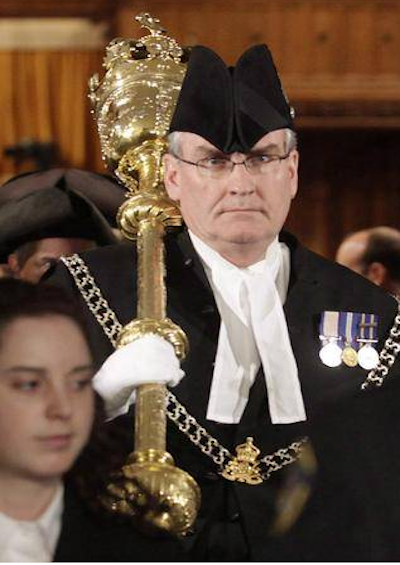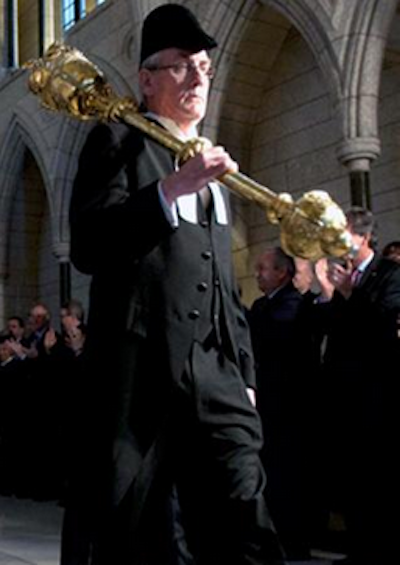Ottawa: A Sergeant-at-Arms As the Real Thing
Competence and the protection of the people’s house.
October 30, 2014

The ancient office of Sergeant-at-Arms – which still persists in countries related to the British parliamentary system – may have originated in the Roman tradition of employing bodyguards for state officials. Some sources hold that the Normans took the idea of the “sergeant” from France to England after 1066. Philip II of France took a corps of guards with him to the Crusades in 1192.
English sources say that King Richard I (the “Lionheart”) of England took 24 with him on his ghastly mission to the Crusades in 1190. The royal role of Sergeant-at-Arms likely extends from 1189 when Richard I was crowned.
In medieval times, the Sergeants-at-Arms originally came from the military. They were the solid, reliable troops from the “middle class,” under the status of the aristocratic knights. English sovereigns did retain “sergeants” to perform specific duties for them, so in the early 13th century, the task assumed the role of a bodyguard.
“Mister Speaker”
The role officially transitioned to parliaments in 1415, when the House of Commons requested a Sergeant, still appointed by the King perhaps to protect the Speaker, as quarrels often ensued between the Speaker, the King and the House of Commons. Henry VIII transferred the authority over the Sergeant to the House of Commons.
The numbers of Sergeants-at-Arms have diminished, their tasks have become more varied and their significance is associated with ceremony – in most countries.
People in the United States are only aware of the role – if even then – when the Sergeant calls out, “Mister [or Madame] Speaker, the President of the United States,” at the annual State of the Union address. Though a U.S. president is not required by the Constitution to give that address each year, he gets to hear that ego-boosting call once a year.
The U.S. House of Representative’s Sergeant assumed that announcing role when the position of “Doorkeeper of the House of Representatives” was abolished in 1995. This aligns with a historical account that the first mention of parliamentary sergeant was as a doorkeeper in 1322.
Wielding the mace
Both houses of the U.S. Congress – and the legislatures of 49 U.S. states (Rhode Island abstaining) – keep Sergeants-at-Arms, who are responsible for security and maintaining order on the floor (generally not needed since members rarely pistol whip or cane each other anymore – at least not since the advent of CNN). They also deploy ceremonial roles frequently bearing a mace.
The U.S. House Sergeant may, as ordered by the Speaker, haul the mace in front of a Member of Congress who is out of order. Just try that now, Speaker or Sergeant, and your job may come into question, since the House itself elects both.
From 2008 to 2012, Britain managed to have its first female “Serjeant,” but that appointment was subject to typical British controversy. Ms. Jill Pay had signed a document allowing police into the House of Commons without a warrant to search the office of a Member of Parliament.
Yet again, historical sources tell us that the earliest sergeants, the Roman bodyguards, had unlimited powers and did not have to adhere to any legalities, which Ms. Pay could have used in her defense.
Nevertheless, Ms. Pay was a mid-level civil servant, not a former military or police officer, so she was not deemed suitable for the post, including by the Queen, who refused her an audience.
Interesting with regard to gender parity, a professional security coordinator for Parliament was appointed and the post of “Serjeant” was downgraded upon Ms. Pay’s appointment.
The Canadians do it better
The Sergeant-at-Arms is the chief security officer of the Canadian House of Commons, appointed by the Governor General and the federal cabinet. The Sergeant does wear a fancy hat and robes and carries a large gold mace into the House at each session in a ceremonial parade. But appearances can be deceiving.
The current Sergeant, Kevin Vickers, evidently takes his role of protecting the House not only very seriously but is also well qualified to handle it.
Most people aware of the news know that it was Mr. Vickers who shot dead the terrorist Michael Zehaf-Bibeau in Ottawa on October 22, 2014. To see this act in context, it’s important to know that Vickers spent 29 years with the Royal Canadian Mounted Police, rose to chief superintendent of the national police in New Brunswick and had been director of security operations for the House of Commons.
It is also important to know that his cousin’s assessment, “He’s a very intelligent and responsible person. He’s a people person-type fellow, too, but you don’t want to mess with him,” was correct.
Indeed. When he heard gunshots from an alcove just outside the entrance of the Parliament’s library and near his office, Vickers – dressed in ceremonial garb but having shed the hat – took out his automatic handgun and ran behind the other side of the large pillar where Bibeau was hiding.
Within two feet of the shooter, he could see the barrel of Bibeau’s Winchester hunting rifle, holding off the security detail that had forced him to hide there.
Vickers dove to the floor around the pillar, spun around to land on his back and fired upwards at Bibeau to kill him. The other security officers then moved in.
A recipient of the Queen’s Jubilee medal, the Canada 125 medal and the RCMP Long Service medal,
Vickers showed that there was reason behind those honors.
When he had been interviewed for the post, Vickers was asked what he wanted from the job. He said, “I told them that if they made me their sergeant-at-arms, there would be no walls built around Canada’s parliamentary buildings.”
After the shooting, he walked around the Parliament, presumably making sure all was secure. No walls needed.
Then he called his mother to tell her he was safe.
Takeaways
Canadian Sergeant-at-Arms Vickers takes protecting Parliament seriously and is well qualified to handle it.
The ancient office of Sergeant-at-Arms is likely as old as the Roman Empire and came to England via the Normans.
Forty-nine of 50 US states have sergeants-at-arms with Rhode Island abstaining.

